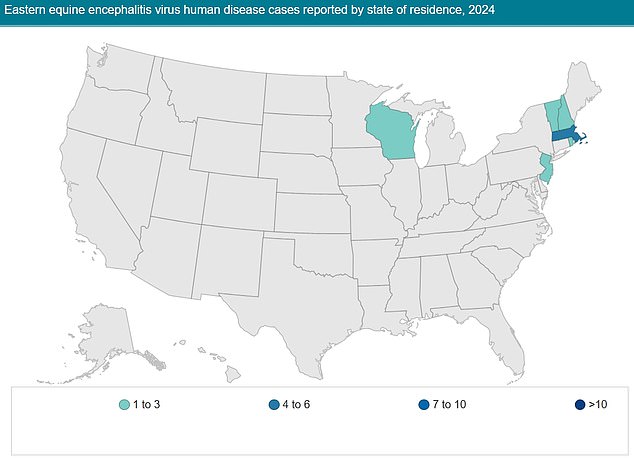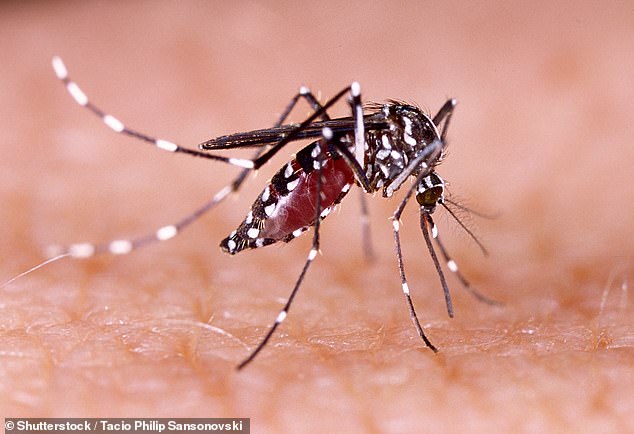New York issues ‘imminent threat to health’ warning as resident dies from seizure-causing infection
New Yorkers have been put on high alert after the state recorded its first death in a decade from an extremely rare but serious mosquito-borne disease.
Governor Kathy Hochul announced that a person in Ulster County, 70 miles (113 kilometers) west of the Connecticut border, had died from eastern equine encephalitis (EEE).
It is the second fatal accident in the US this year. The first involved a 41-year-old man from New Hampshire who died in August.
The disease is spread by infected mosquitoes, which kill about a third to a half of their victims. Often, severe encephalitis develops, leading to seizures, headaches, and eventually brain death.
Parks in New York State will now provide mosquito repellent to visitors, post signs to raise awareness about the disease, and consult with health officials about setting park hours and limiting activities during times of day when mosquitoes are most active.
The death was reported in a resident of Ulster County, New York, located about 70 miles from the Connecticut border
This year, human cases of the disease have also been reported in Massachusetts, New Jersey, Rhode Island, Vermont and Wisconsin.
This year, the U.S. has seen an unusually high number of cases. And while infection is rare, there is no vaccine to protect against it.
Governor Kathy Hochul death addressed on September 20, but provided limited details about the patient as he remains “under investigation by the Ulster County Public Health Department.”
She added: “The safety of New Yorkers is my top priority.
“Following the first confirmed human case of EEE, my administration took statewide action to help protect communities. With today’s declaration, we are making more state resources available to local departments to support their public health response.”

New York’s first human case of EEE since 2015 was confirmed in Ulster County, NY (pictured). The patient died on September 20. (Photo credit: Daniel Case/GFDL)

The CDC map shows cases of EEE reported in the U.S. this year. It has not yet been updated to show the case in New York
Many people infected with EEE do not show symptoms because their immune system can fight off the virus.
Only four to five percent of people infected with the EEE virus become seriously ill.
But people under 15 and over 50 are generally less fortunate. Young and old people have relatively weaker immune systems than other adults.
These groups are also more susceptible to the serious neurological effects of infections because their blood-brain barrier, the protective layer around the brain that protects the brain from infections, is still developing or decreases with aging.
Only a few cases are reported each year, but the number of cases per year can vary.

Steven Perry, 41, of Hampstead, New Hampshire, died after a seven-day battle with Eastern Equine Encephalitis

He was rushed to hospital on August 12 after his family noticed him acting strangely, but was pronounced dead on August 19 – a week later
In 2019, the US saw its largest outbreak in about 50 years, with 38 cases and 19 deaths, compared to the seven severe cases that are typical each year.
It cannot be spread from person to person, only through the bite of an infected mosquito. Evidence suggests that infected mosquitoes are on the rise in New York. Infected insects have been found in 15 New York boroughs this year, compared to the usual two to three cases annually.
State Health Commissioner Dr James McDonald said: ‘Eastern equine encephalitis is different this year.
“While we normally see these mosquitoes in two to three counties each year, so far this year they have been in 15 counties and across New York State. This life-threatening mosquito-borne disease has no commercially available human vaccine and must be taken seriously. Mosquitoes, once a nuisance, are now a menace.”
New York isn’t the only state on high alert. In Massachusetts, 10 of its 14 counties have been warned about the increased prevalence of mosquitoes and have imposed curfews.

Several different types of mosquitoes can transmit this virus, but a common species is the cattail mosquito, whose scientific name is Coquilleta perturbans. This mosquito is found in the eastern and midwestern United States
For example, the city of Plymouth, population 60,800 and about 40 miles (64 kilometers) from Boston, will close its outdoor recreation areas from dusk to dawn every day after a horse in the city tested positive for the virus.
Vermont also postponed public events, including nighttime festivals and concerts, to help curb the spread of the deadly virus. State health officials are “strongly recommending[s]’ that people in some of the state’s busiest cities are staying indoors between 6 p.m. and 6 a.m., when insects are most active.
In August, Vermont reported its first case of the mosquito-borne disease since 2012.
Mosquitoes remain a public health nuisance until about mid-October, when the mosquito season ends.
